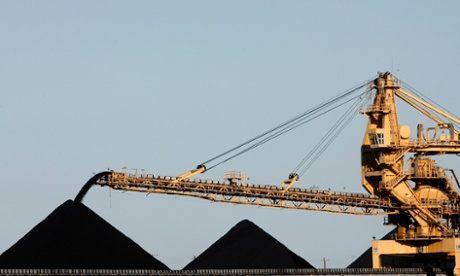While the world digests the IPCC’s 5th assessment of our carbon emissions and changing climate, plans abound for an unprecedented coal export boom in Australia. In the remote, as yet untapped inland Galilee Basin region of central Queensland, the fuse is set to be lit on a carbon bomb. Nine huge open cut coalmines with lifespans of up to 90 years will produce a total of 330m tonnes of thermal coal each year, to be burnt in the power stations of India, China and any other country that still resorts to coal-fired power as an energy source in the 21st century.
One of these, the 30m tonne per year Alpha coal mine owned by Indian giant GVK and Gina Rinehart’s Hancock Coal, is currently the subject of a court challenge by a local environment group and farmers. They are objecting on the grounds of the mine’s devastating climate and water impacts.
The expansion of the Australian coal export industry is strongly supported by the new, enthusiastically pro-mining conservative government, which is energetically dismantling Australia’s climate change mitigation policy framework. Yet the policy to “dig it up, ship it out and let it burn” is dangerously at odds with the consensus that to keep the world from more than two degrees of warming, a substantial amount of current fossil fuel reserves must stay in the ground.
The Galilee Basin is drawing attention for the sheer size and global impact of the development proposal there. The coal from the nine mines, when burnt, will pump 705m tonnes of CO2 into the atmosphere every year – a level of emissions surpassing that of all but six of the nations of the world. The UK’s total emissions from all sources in 2011, by comparison, was 549.3m tonnes of CO2.
The emissions from these mines alone would amount to around 130% of Australia’s current total annual emissions. Yet the Galilee coal expansion has been partly able to escape international scrutiny because Australia’s national carbon emissions do not account for emissions produced by Australian coal if it is not burnt on Australian soil.
The IPCC’s newest report tells us that the world has emitted about half a trillion tonnes of carbon over the past 250 years, causing atmospheric carbon dioxide levels to rise by 40%. We are now on track to release another half trillion tonnes in just a few decades.
Last year, Carbon Tracker released a report called Unburnable Carbon. Drawing on the work of the Potsdam Climate Institute, which in 2009 produced a set of emissions scenarios and their likely influence on global temperatures, it showed that for there to be about an 80% chance of keeping global warming to two degrees or less, 60 to 80% of existing fossil fuel reserves must be kept in the ground. The “carbon budget” for coal — the amount that can be emitted if we are to avoid catastrophic climate change — is about 200 gigatonnes.
As a report this year by Carbon Tracker and The Climate Institute showed, Australian coal resources, if burnt, would use up 75% of the precautionary 200 gigatonne global carbon budget for coal.
In fact, what makes Australia’s burgeoning coal boom so problematic is that it reduces our chances of achieving the emissions reductions needed to keep the world at two degrees of warming. Greenpeace analysis warns that the growth in coal-fired emissions represented by the nine Queensland coalmines would be in line with the International Energy Agency's model of a "catastrophic" six degree rise in temperatures.
Coupled with the dramatic climate risks posed by Australian coal, there is very high investment risk of a "carbon bubble" scenario. With many major economies like China tightening their restrictions on carbon and developing policies to transition to renewable energy, billions of dollars of investment tied up in coal risk becoming “stranded assets”.
Investors need to challenge the assumption that coal demand will continue to rise in China and elsewhere, otherwise billions of dollars or taxpayer, superannuation and shareholder funds will be wasted in assets linked to unburnable carbon.
Australia does not need to continue on the fossil fuel path. Its windy coastline, abundance of sunlight and educated workforce makes it uniquely well placed to develop a world-leading renewable energy industry that can be exported internationally. Studies from the University of Melbourne, University of NSW and most recently the government's own Australian Energy Market Operator have shown that Australia could transition to 100% renewable energy within a decade or two for around the same cost as continuing business as usual. Solar power continues to drop in price faster than was predicted.
That is where the future lies. Australia has a generational opportunity to boost its economy and help power the world without contributing to catastrophic global warming. As a first step, it should seriously re-consider lighting the fuse on the coal carbon bomb in the Galilee Basin.

